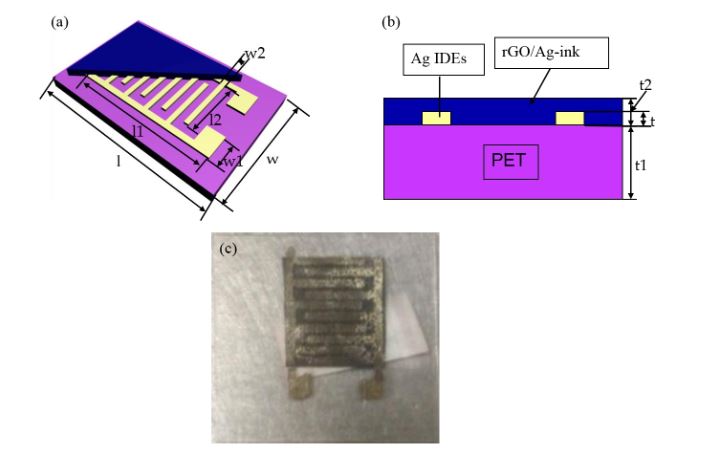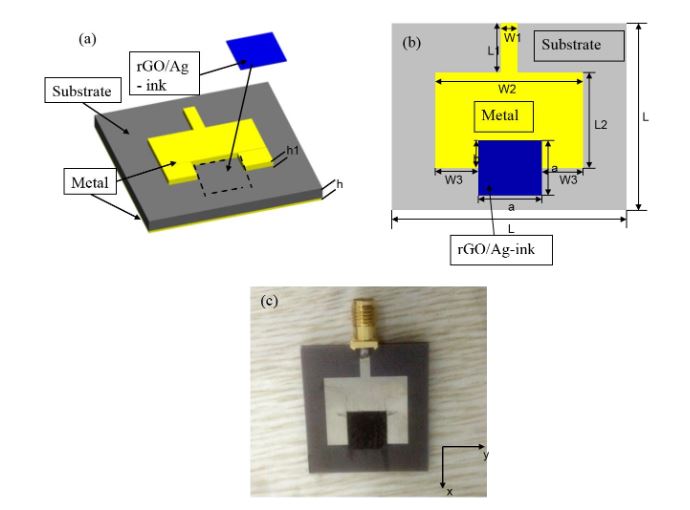ABSTRACT
Reduced graphene oxide (rGO) has been studied as a resistive ammonia gas sensor at room temperature. The sensitive hybrid material composed of rGO and nano-silver ink (Ag-ink) was loaded on a microstrip patch antenna to realize high-performance wireless ammonia sensors. The material was investigated using scanning electron microscopy (SEM) and X-ray photoelectron spectroscopy (XPS).
Firstly, interdigital electrodes (IDEs) printed on the polyethylene terephthalate (PET) by direct printing were employed to measure the variation of resistance of the sensitive material with the ammonia concentration. The results indicated the response of sensor varied from 4.25% to 14.7% under 15–200 ppm ammonia concentrations. Furthermore, the hybrid material was loaded on a microstrip patch antenna fabricated by a conventional printed circuit board (PCB) process, and a 10 MHz frequency shift of the sensor antenna could be observed for 200 ppm ammonia gas.
Finally, the wireless sensing property of the sensor antenna was successfully tested using the same emitted antenna outside the gas chamber with a high gain of 5.48 dBi, and an increased reflection magnitude of the emitted antenna due to the frequency mismatch of the sensor antenna was observed. Therefore, wireless ammonia gas sensors loaded on a patch antenna have significant application prospects in the field of Internet of Things (IoTs).
SYNTHESIS AND CHARACTERIZATION

Figure 1. Schematic and physical map of the coated interdigital electrodes (IDEs) with reduced graphene oxide
In Figure 1, Ag-ink was bought from a commercial company (KunShan Hisense Electronics CO, KunShan, China). Microplotter II (Middleton, WI, USA) was employed to print interdigital electrodes (IDEs) on a flexible PET and heated on the hot plot for 30 min at 145◦C. The dimensions of the proposed IDEs sensor with rGO/Ag-ink are given in Table 1. Figure 2 illustrates the proposed sensor antenna with rGO/Ag-ink, and the dimensions are given in Table 2.

Figure 2. Schematic and physical map of the microstrip patch antenna with rGO/Ag-ink
Figure 2 illustrates the proposed sensor antenna with rGO/Ag-ink, and the dimensions are given in Table 2. The patch antenna with a gap was fabricated by a conventional printed circuit board (PCB) process. More stable Teflon was used as the substrate of the patch antenna. Then, the volume feed ratio of Ag-ink to as-prepared rGO solution was set as 1:1 and sonicated for 30 min. For the last stage of fabrication, the mixture was placed in the designated gap area and sit for additional 24 h at room temperature.
EXPERIMENTAL RESULTS AND DISCUSSIONS

Figure 4. Scheme of ammonia gas characterization for IDEs sensor with rGO/Ag-ink
In order to evaluate the dynamic response and sensitivity of the proposed rGO/Ag-ink sensor, the IDEs covered by the rGO/Ag-ink hybrid were placed into the self-made chamber and connected to the Keithley 2612A Source Meter (Figure 4).

Figure 8. Wireless sensor monitoring of ammonia gas
The emitted antenna was connected to a vector network analyzer (VNA), while the sensor antenna was set inside the gas chamber connected to the standard load impedance via an SMA connector. Two antennas were placed face to face with a distance between them of about 200 mm, as shown in Figure 8a.
CONCLUSIONS
In this paper, a novel wireless ammonia sensor loaded on a microstrip patch antenna operating at a microwave frequency with rGO and nano-silver ink as a hybrid sensing material was proposed, demonstrating a low-cost and feasible method of gas detection. Combining an ammonia sensor with a high gain patch antenna, which can detect different concentrations of ammonia while maintaining the characteristic of the patch antenna itself, is a creative idea.
Compared with coil antennas and dipole antennas, the patch antenna has more advantages with a wireless sensor, as shown in Table 3. More importantly, it will detect toxic gases effectively, while avoiding potential harm to the human body. In other words, long-distance wireless sensor detection can be achieved. Thus, the proposed devices will be an indispensable component for Internet of Things (IoTs).
Source: Xidian University
Authors: Bian Wu | Xingfei Zhang | Beiju Huang | Yutong Zhao | Chuantong Cheng | Hongda Chen
>> Final Year Project on Microstrip Antenna for Engineering Students